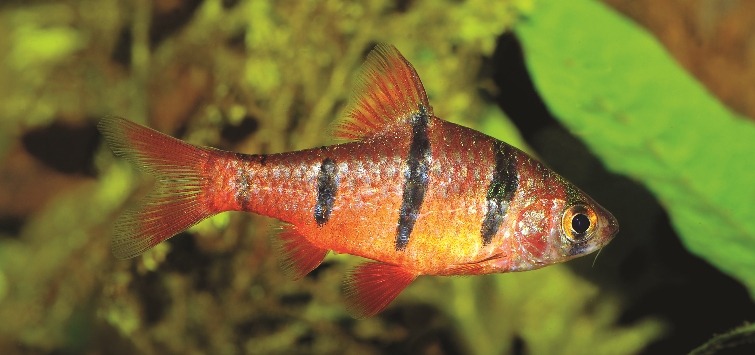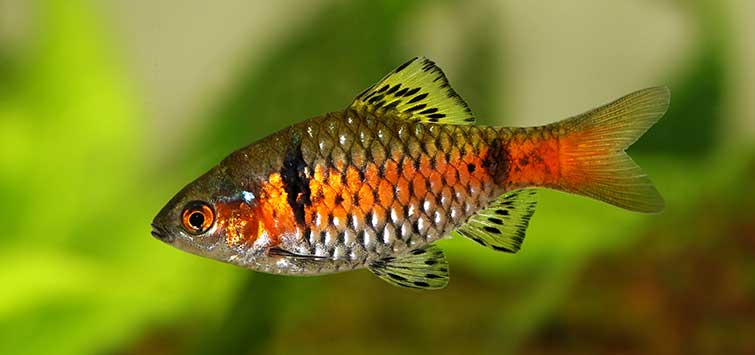Terrific Tiger Barbs (and a Few Stripey Cousins)
Mike Hellweg
Mention barbs and the first thing most hobbyists think of is the ubiquitous tiger barb. Arguably the most popular, one of the most colorful, and at the same time the most disliked of the barbs, it is also the source of the false rumor that all barbs are aggressive. Nothing could be further from the truth!
So, are tiger barbs aggressive? When properly maintained, tiger barbs are no more aggressive than any other fish, and a large school of them in a decent-sized planted tank is truly a sight to behold.
The source of this dichotomy of opinion on tiger barb aggression is likely due to newer hobbyists who want a little of everything to stock their first community tank. They see all the beautiful fish in their local shop and want two of these, one of those, a blue one, a red one, etc., not really knowing that while some of these fish are fine as the only representative of their species, many really would do better in a school or group of their own kind.
The tiger barb fits in this latter category. They are active fish, always on the move. They do best in larger schools of at least eight to a dozen fish, and even better with more. They set up a hierarchy in the group by nipping and chasing each other—that’s their natural behavior. No harm is done because they all are playing the same game and understand the rules.
When there are only a few tiger barbs in the tank mixed in with angelfish, guppies, and/or other longer-finned, slower-moving fish, the tiger barbs still want to set up their hierarchy and play their games. Unfortunately, the other fish don’t know the rules.
Their continuous playful nipping becomes harassment; those long, flowing fins get chewed up, and the beautiful tiger barbs are branded as mean bullies. All they are doing is being tiger barbs! Unfortunately, the hobbyist, once burned, applies that “aggressive” label as standard barb behavior, and all fish in the group are painted with the same brush.
Tiger Barbs

In the wild, tiger barbs fill the ecological niche that their minnow cousins fill here in North America. They are found in moving water in shallow clearwater creeks, streams, and sometimes roadside ditches. They seek out open water and prefer cooler, shaded areas of the habitat.
They live in schools of a few dozen to several dozen individuals and are constantly on the move up and down stream, feeding as they go. They are omnivores, eating insects, worms, and small crustaceans, and nibbling at algae and other plant matter. They generally ignore other fish.
These barbs grow into fairly stocky fish of a little over 2 inches (5 cm) long, so an ideal aquarium for a minimal school of eight to a dozen or so would be long and low. Instead of mounting the filter on the rear of the tank, put it on one of the sides to create a flow that moves from one end of the tank to another, reminiscent of a stream.
Plants and other décor can be added along the back and sides, but the front and middle of the aquarium should remain open for the tiger barbs to spend most of their time doing what they do best—swimming in the current and chasing each other. Limit companions to fish like loaches, plecos, or, if the tank is big enough, maybe a small group of another species of barb, like black ruby barbs or something similar.
While wild tiger barbs are found mostly in soft, acidic water, the fish that we encounter in shops today are not wild caught. They have been raised on farms in Southeast Asia, Europe, and Florida under a wide variety of conditions for more than 90 years, making the fish that we have access to today a very hardy, adaptable animal that isn’t demanding as to water parameters.
They do still need clean, clear water, so a well-maintained filter producing good flow is in order. Large, regular water changes, along the lines of 30 to 50 percent a week, will help keep them happy. They prefer cooler water, so most tanks won’t need a heater or should have one set to about 70°F (21°C) just to keep it from going too low.
The farmed tiger barb of today is available in several color variants—wild type, green, albino, gold, and more. There are also long-finned variants of each, but considering the tiger barbs’ habit of nipping and chasing each other, those long fins are usually in tatters, so these fish would be best not kept. If you do choose to keep them, bear in mind that the long fins slow individual fish down and put them at a disadvantage in the hierarchy, so you should not mix short- and long-finned variants.
Currently, the tiger barb is scientifically known as Puntigrus tetrazona. If you look for information from older sources, depending on when and where the source was written, you may find the tiger barb in different genera, including Puntius, Capoeta, and Barbus, as the genus Puntigrus is comparatively new.
There is even some argument among scientists that the fish we know as the tiger barb is actually a different species entirely—Puntigrus anchisporus—and that the true P. tetrazona has never been imported for the hobby at all!
Fortunately for us, “tiger barb” works just fine, and everyone knows exactly what we’re talking about. Most likely, the tiger barb is among the ranks of aquarium fish that are complex, unknowable hybrids that have been domesticated.
Feeding
Feeding couldn’t be easier. Since they are farm-raised, tiger barbs are very happy eating a diet of commercial foods. Flakes, pellets, and/or gel foods with a veggie component are perfect for them. At least once a week, add frozen foods like brine shrimp, bloodworms, mysis, daphnia, or something similar to round out their diet.They can even be conditioned for breeding with commercial foods, though adding live foods like worms, brine shrimp, daphnia, or similar fare will help with both egg and milt production.
Breeding & Fry Care
Tiger barbs are fairly easy to induce to breed. All that is needed is to separate a large, well-rounded female from the main tank and move her to a smaller tank that will be used for breeding. Feed her two to three times a day on frozen and live foods for a week or so, then give the tank a good cleaning, vacuuming the bottom of the tank and washing the filter well.
Add a spawning grid or a pile of coarse rocks, or even glass marbles if you can find them. The idea is to provide a barrier to separate the parents from their eggs. Put in a pile of fine-leaved plants like Java moss, and, finally, add the male right before lights out.
Generally, they will spawn at first light, and by the time you are up and about, they will be done. At this time, remove the adults, turn the filter down to a very slow trickle, and wait.
The eggs will hatch in 24 to 36 hours depending on temperature, and the fry will be seen as tiny slivers hanging all around the tank. After about four to five days, they will start making their first attempts at swimming, and by the next morning, they will all be up in the water column.
Now it’s time to feed them. You can use a finely powdered commercial diet for egglayer fry, a pinch of hard-boiled egg yolk swirled in a glass of tank water to create a fine slurry, or infusoria if you have access to a culture. Especially if you’re feeding egg yolk, be sure to do a water change every day and add a few small snails to help clean up any uneaten food.
Tiger barb fry grow quickly. After a week or so, they will be ready for larger fare like newly hatched brine shrimp or finely ground flake food. As they grow, perform large, regular water changes and step up the food particle size. After about six weeks, they will be nearly an inch (2.5 cm) long and ready for new homes.
Other Stripey Barbs
There are several other barbs with stripes that are often confused with the tiger barb, even by experienced hobbyists and shop employees. One of the most widely available and most often confused with the tiger barb is the black ruby barb (Pethia nigrofasciata).
Black ruby barbs grow to about 2½ inches (6 cm) and can be kept in planted community tanks with other peaceful fishes. They, too, prefer cooler water and will do just fine without a heater, but they can tolerate water up to about 78°F (26°C) if the other fish in the tank need it.
Males in full color are actually one of the most beautiful of all fishes—they have to be seen to be believed! I won the very first fish show that I entered and took both Best in Show and the Judge’s Award with a male black ruby barb that spent the entire morning of judging courting a female entry in the next tank over (which was another fish of mine).
They are often overlooked in dealers’ tanks because they are usually stressed and in poor color under those conditions. Give them a planted tank and they literally glow. They are peaceful, slow-moving, and completely unaggressive. Males spar by flashing colors and doing a little dance around each other, holding their fins erect, without any harm being caused.

There is a group of striped barbs in the genus Desmopuntius: D. pentazona, the five-striped barb; D. hexazona, the six-striped barb; and D. rhomboocellatus, the snakeskin barb, sometimes called the camouflage barb. They each reach about 2 to 3 inches (5 to 7.5 cm), have narrower bodies than the aforementioned barbs, and are much more shy.
They prefer typical tropical-fish water temperatures, around 76° to 78°F (24° to 26°C). In dealers’ tanks, as with the black ruby barb, these fish also look washed out due to being stressed by lack of cover. They love planted tanks, where they will spend much of their time moving through the plants looking for food.
Once moved into a planted tank, all three species begin to glow. They are beautifully colored, with red/orange bodies and black stripes. In males, the entire flanks of all three species are covered with a bright metallic green sheen. They are more often available now as farmed fish and not quite so demanding as to water parameters as their ancestors were just a few decades ago.
Given a well planted tank, all of them will do well in most hobbyists’ local water, and they are peaceful with other fishes. Commercial diets will suit them just fine, and they are appreciative of an occasional treat of small frozen or live food.
They are all much more challenging to breed than their larger tiger cousins. For breeding, softer, more acidic water is required, and the tank should have several bunches of fine-leaved plants. Their slow-growing fry generally don’t go for commercial foods and need infusoria as food for the first week. After this, they can be switched to live baby brine shrimp. At about 30 days, you can start adding commercial foods, and, from then on, raising them is fairly straightforward.
Great Fish with a Bad Reputation
Don’t let the name “barb” scare you away from the wonderful experience of keeping any of the striped barbs. Just realize that, like all other fish, they have special needs that have to be met, and otherwise they just won’t be happy.And my usual aquarium-keeping advice applies: Don’t forget to spend time sitting in front of your tank watching your fish! Isn’t that why we all got into this wonderful hobby in the first place?

.png?h=595&iar=0&w=2781&hash=5FD5E69473BCC22199FBFA2FB71B6033)



